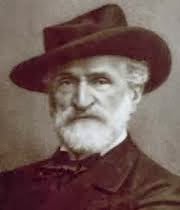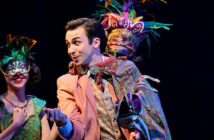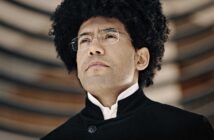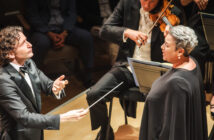Advertisement / Publicité
Verdi: Messa da Requiem
Hui He, soprano
Marianne Cornetti, mezzo-soprano
Giorgio Berrugi, tenor
Ain Anger, bass
Dallas Symphony Chorus and Orchestra/Jaap van Zweden
Meyerson Symphony Center
Dallas, Texas
Sunday, February 23, 2014
It wasn’t the first time that Jaap van Zweden had conducted Verdi’s Messa da Requiem in Dallas, it hopefully won’t be the last, and it was memorable in all the right ways. The climaxes were stupendous, the quiet moments were ethereal, and the entire work held together as a deeply-felt lament for the dead.
 |
| Giuseppe Verdi |
The Verdi Requiem is a theatrical piece in the sense that Verdi was primarily an opera composer. He didn’t write any symphonies or concertos and concentrated his energies on writing for the operatic stage in his native Italy. The melodies and choruses in this work would fit very well into one of his operas; parts of the “Dies Irae,” for example, could have been used for the “auto de fé” scene in Don Carlo. The dramatic approach works in the Requiem; after all, there is nothing more dramatic in anyone’s life than the leaving of it. Most people are fearful of death, wondering what, if anything, comes next and desperately seeking to come to terms with what they have made of their lives. Verdi has plumbed the depths of these anxieties in his Messa da Requiem, and it is one of his greatest works.
Jaap van Zweden brings to every score he conducts an enormous respect for the composer, and a commitment to bringing that music to life. While his integrity will not allow him to exaggerate for greater effect, this approach never results in a scholarly or dull performance; what van Zweden achieves is an intensity which imbues every note in a score with life and meaning – and so it was with this performance of Verdi’s Messa da Requiem. The opening bars might have been a little softer than they needed to be, but in straining to hear those muted cello notes we were drawn into the mystery of death right from the beginning. When the music modulates to F major and Verdi indicates a slightly faster tempo for this choral section, Maestro van Zweden’s beat was markedly faster – again, a convincing tempo change because it was done with conviction, and further on, with the most beautiful phrasing and tapering of dynamics. Masterful.
Mezzo-soprano Marianne Cornetti a Casting Coup
Verdi has given the soloists in this work the most commanding entries imaginable. Tenor, bass and soprano each have four bars in which to assert themselves as major players in the drama. From these few, but telling, bars we learn early on whether or not our soloists have what it takes to carry Verdi’s message; unfortunately, on this afternoon the soloists seemed not quite ready for the task at hand, either because they had not warmed up sufficiently before the performance or because they had been miscast.
Soprano Hui He was more in command later in the work – especially in the final movement, the “Libera me.” Tenor Giorgio Berrugi also improved as he went along, and was especially successful in the more lyric passages. From the bass in this work, I prefer a heavier and darker sound than Ain Anger was able to provide. He was especially weak in the chilling “Mors stupebit” section.
 The vocal range of the mezzo-soprano role is all too easily covered by Verdi’s chorus and orchestra in this work; Marianne Cornetti (photo:right) whose voice is much bigger than that of the other three soloists, used this strength to good effect.
The vocal range of the mezzo-soprano role is all too easily covered by Verdi’s chorus and orchestra in this work; Marianne Cornetti (photo:right) whose voice is much bigger than that of the other three soloists, used this strength to good effect.
Special kudos to the members of the all-volunteer Dallas Symphony Chorus. Named Director of the chorus in 2010, Joshua Habermann has shown that he can successfully maintain the high standard set by former director David R. Davidson. Jaap van Zweden needed only to look in the direction of sopranos or tenors to elicit the most remarkable results; each member of the chorus seemed supremely attentive to every move the conductor made. The results were glorious.

 The vocal range of the mezzo-soprano role is all too easily covered by Verdi’s chorus and orchestra in this work; Marianne Cornetti (photo:right) whose voice is much bigger than that of the other three soloists, used this strength to good effect.
The vocal range of the mezzo-soprano role is all too easily covered by Verdi’s chorus and orchestra in this work; Marianne Cornetti (photo:right) whose voice is much bigger than that of the other three soloists, used this strength to good effect.















